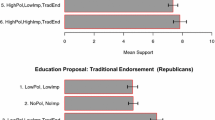Abstract
Differences in voters' fiscal preferencesare examined taking advantage of theexceptional Swiss institutional setting.Empirical evidence suggests thatpreferences are determined by strictlycultural patterns (cultural area measuredby language). Thus, fiscal preferences canbe considered as being largely exogenous.This implies that, except for specialcases, it is not possible to find simpleproxy variables for fiscal preferences. Anad hoc index of fiscal preferencesought to be built up when the introductionof this variable is required forcomprehensive explanatory models of fiscaldiscipline or for other related studies.
Similar content being viewed by others
References
Alesina, A. and Bayoumi, T. (1996). The costs and benefits of fiscal rules: Evidence from U.S. states. NBER Working Papers, No. 5614, National Bureau of Economic Research, June.
Alesina, A. and Perotti, R. (1995). The political economy of budget deficits. IMF Staff Papers 42: 1-31.
Alesina, A. and Perotti, R. (1997). Fiscal adjustments in OECD countries: Composition and macroeconomic effects. IMF Staff Papers 44: 210-248.
Alesina, A., Roubini, N. with Cohen, G. (1997). Political cycles and the macroeconomy. The MIT Press, Cambridge, Massachusetts.
Bayoumi, T. and Eichengreen, B. (1995). Restraining yourself: The implications of fiscal rules for economic stabilization. IMF Staff Papers 42: 32-48.
Bohn, H. and Inman, R. (1996). Balanced budget rules and public deficits: Evidence from the U.S. states. NBER Working Papers, No. 5533, National Bureau of Economic Research, April.
C2D, Centre d'Etudes et de Documentation de la Democratie Directe (2001). Tableau de la démocratie directe au niveau fédéral, as it was present in november 2001 (http://droitsun1.unige.ch/c2d/direct_demo_federal/table_resume.html).
Dafflon, B. and Pujol, F. (2001). Preferences and fiscal discipline: Swiss cantonal evidence, International Public Management Review 3: 54-78.
Feld, L. and Kirchgässner, G. (1999). Public debt and budgetary procedures: Top down of bottom up? Some evidence from Swiss municipalities. In: J. Poterba and J. von Hagen (Eds.), Fiscal institutions and fiscal performance, 507-538. Chicago: Chicago University Press.
Grisel, E. (1987). Initiatives et référendum populaires. Traité de la démocratie semi-directe en droit suisse, Institut de droit public de l'Université de Lausanne, Dorigny.
Holtz-Eakin, D. (1988). The line item veto and public sector budgets. Evidence from the states. Journal of Public Economics 36: 269-292.
Hofstede, G. (1984). Culture's consequences. International differences in work-related values. Beverly Hills: Sage Publications.
Imbeau, L. (2000). Political-economy of budget deficits: A critical appraisal of the literature, Paper presented at the 2000 APSA Congress, Quebec unit.
Peltzman, S. (1992). Voters as fiscal conservatives. The Quarterly Journal of Economics 107: 327-361.
Persson, T. et Tabelllini, G. (1999). Political economics and macroeconomic policy. In: J. Taylor and M. Woodford (Eds.), Handbook of macroeconomics, Vol II.
Pommerehne, W. (1978). Institutional approaches to public expenditure. Journal of Public Economics 9: 225-280.
Pommerehne, W. and Schneider, F. (1978). Fiscal illusion, political institutions, and local public spending. Kyklos 31: 381-408.
Poterba, J. (1995). Balanced budget rules and fiscal policy: Evidence from the states. National Tax Journal 48: 329-336.
Poterba, J. (1996). Budget institutions and fiscal policy in the U.S. states. American Economic Review 86: 395-400.
Rohr, J. (1987). La démocratie en Suisse. Paris: Economica.
Shoenenberger, A. and Zarin-Nejadan, M. (1996). L'économie Suisse. Paris: Presses Universitaires de France.
Stein, E., Talvi, E. and Grisanti, A. (1998). Institutional arrangements and fiscal performance: The Latin American experience. NBER Working Papers, No. 6358, National Bureau of Economic Research, Cambridge, January.
Von Hagen, J. (1998). Budgeting institutions for aggregate fiscal discipline. ZEI Policy Paper, N. B98-01.
Von Hagen, J. and Harden, I. (1994). National budget processes and fiscal performance.European Economy Reports and Studies 3: 311-418.
Author information
Authors and Affiliations
Rights and permissions
About this article
Cite this article
Pujol, F., Weber, L. Are Preferences for Fiscal Discipline Endogenous. Public Choice 114, 421–444 (2003). https://doi.org/10.1023/A:1022633632079
Issue Date:
DOI: https://doi.org/10.1023/A:1022633632079




